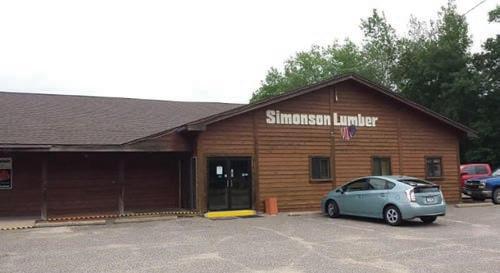COMPETITIVE Intelligence By Carla Waldemar
Buy, Baby, Buy
CROSSLAKE, Mn., one of 15 locations operated by fast-growing independent Simonson Lumber.
s a little kid, Richard Hobbs had big plans. “When I grow up, I want to be a Senator,” he told his mother. As second-generation co-owner with her husband of Simonson Lumber, today headquartered in St. Cloud, Mn., she delivered the verbal equivalent of a slap up the head: “So everything Grandpa Nels worked for would be wasted?” The Senate’s loss. “I never worked anywhere else,” allows Richard, now 70. “I started in, at age 10, along with my brothers, riding my bike to work for a dime an hour. I’ve done every job from janitor to cashier, bill collector, hauler, yard manager. Everything.” Just like Grandpa Nels, whose work history involved renting land on a handshake for the first of his cache of lumberyards, dating back to 1913. (He also sold Model T parts and snow fences. Oh, and a gas station or two.) “He was a remarkable man; stories abound. If he were alive today, he’d still be innovating,” says Richard, who’s assumed that role, along with the tendency to buy and sell yards around Minnesota as if they were used cars. When his parents became ill in the early ’90s, Richard officially took the helm and drove the revenue from an annual $7 million to well over $60 million before the recent recession. His first Aha! move was in consolidating a miniempire which had sprawled, over time, to 15 yards—always a fluid number as companies were bought and sold. Today there are four Simonson yards outstate and two in St. Cloud plus a truss plant, acquired with a recent purchase of St. Cloud’s highly-regarded Mathew Hall outfit upon its owner’s death in 2019. “Our yards were all competitive rather than cooperative, however; no centralization,” he says. “Each, for instance, had its own bookkeeper. A negative feature of small yards
A
30
n
The Merchant Magazine n
April 2021
is the overhead. So I consolidated things like accounting and purchasing. Today, it’s all cars or trucks, which small yards cannot do: a disadvantage for them. It would make me mad,” he remembers, back at the outset. “They’d tell me, ‘I’ll sell you three units off a truck.’ ‘No!’ I’d come back. ‘Instead, tell me how to achieve a better store! Tell me how to earn it!’ That’s really important to me. That’s where we want to be.” And now, that’s right where Simonson is. Richard boasts three full-time buyers. “I just hired a lumber buyer who saved our neck as prices tripled.” They’re part of a staff of 200 “talented people, who make enormous sacrifices to work for us. We’ve seen it all since 1913, made the mistakes, to grow larger, achieve good market penetration, do mergers. But!” he emphasizes: “What’s even more important is, how much we all care for each other. “I hope to lead the staff by example. I take on young people and write ‘grace and compassion’ into the job description. We’re ‘the company of many chances,’ so you won’t get fired. I won’t get mad at you. We’ll use grace and compassion. These days, of course, we’ve grown to have an HR Department, headed by Michelle, who’s really bought into the idea that ‘We’ll make it work for you’.” Low to no turnover, then. Super loyalty. “When we buy a yard, we keep on the people—and the customers,” he reports: “even people who said they’d never darken my door. When we bought Mathew Hall, the three Hall kids stayed on. It’s all about the people,” Richard reiterates what’s become his mantra. And those all-important people include—indeed, are venerated—the contractors who shop at Simonson, who represent over 90% of its customers. “What do they like about us?” Richard muses. “That we buy cars and trucks,” thanks to the volume-purchasing power his multiple yards delivers. “Those contractors are tough guys,” he praises. “So much is asked of them, so you want to help those guys out. It’s a teaching thing,” he points out. “If they were all so wonderful, vendors wouldn’t need us; they’d deal direct.” What those pros are building, says Richard, “has changed dramatically over the past 10 years. Now, multifamily is the big trend. Although my parents taught me, ‘Too many apartments!’ that’s not the case today. And that’s a big reason why we just bought Mathew Hall— because they had a truss plant we couldn’t compete with. Now,” he instructs, “it’s time to experiment with wall panels. Hall has a wall panel line, and 25% of its business was in those panels.” Building-Products.com


















